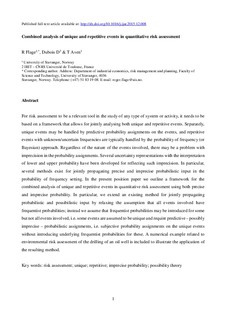| dc.contributor.author | Flage, Roger | |
| dc.contributor.author | Dubois, Didier | |
| dc.contributor.author | Aven, Terje | |
| dc.date.accessioned | 2019-10-29T14:28:15Z | |
| dc.date.available | 2019-10-29T14:28:15Z | |
| dc.date.created | 2016-04-22T18:06:08Z | |
| dc.date.issued | 2016-03 | |
| dc.identifier.citation | Flage, R., Dubois, D., Aven, T. (2016) Combined analysis of unique and repetitive events in quantitative risk assessment. International Journal of Approximate Reasoning, 70, pp. 68-78. | nb_NO |
| dc.identifier.issn | 0888-613X | |
| dc.identifier.uri | http://hdl.handle.net/11250/2625209 | |
| dc.description.abstract | For risk assessment to be a relevant tool in the study of any type of system or activity, it needs to be based on a framework that allows for jointly analyzing both unique and repetitive events. Separately, unique events may be handled by predictive probability assignments on the events, and repetitive events with unknown/uncertain frequencies are typically handled by the probability of frequency (or Bayesian) approach. Regardless of the nature of the events involved, there may be a problem with imprecision in the probability assignments. Several uncertainty representations with the interpretation of lower and upper probability have been developed for reflecting such imprecision. In particular, several methods exist for jointly propagating precise and imprecise probabilistic input in the probability of frequency setting. In the present position paper we outline a framework for the combined analysis of unique and repetitive events in quantitative risk assessment using both precise and imprecise probability. In particular, we extend an existing method for jointly propagating probabilistic and possibilistic input by relaxing the assumption that all events involved have frequentist probabilities; instead we assume that frequentist probabilities may be introduced for some but not all events involved, i.e. some events are assumed to be unique and require predictive – possibly imprecise – probabilistic assignments, i.e. subjective probability assignments on the unique events without introducing underlying frequentist probabilities for these. A numerical example related to environmental risk assessment of the drilling of an oil well is included to illustrate the application of the resulting method. | nb_NO |
| dc.language.iso | eng | nb_NO |
| dc.publisher | Elsevier Ltd. | nb_NO |
| dc.rights | Attribution-NonCommercial-NoDerivatives 4.0 Internasjonal | * |
| dc.rights.uri | http://creativecommons.org/licenses/by-nc-nd/4.0/deed.no | * |
| dc.subject | risikostyring | nb_NO |
| dc.subject | sannsynlighetsregning | nb_NO |
| dc.title | Combined analysis of unique and repetitive events in quantitative risk assessment | nb_NO |
| dc.type | Journal article | nb_NO |
| dc.type | Peer reviewed | nb_NO |
| dc.description.version | acceptedVersion | nb_NO |
| dc.rights.holder | Copyright © 2015 Elsevier Inc. All rights reserved. | nb_NO |
| dc.subject.nsi | VDP::Social science: 200 | nb_NO |
| dc.source.pagenumber | 68-78 | nb_NO |
| dc.source.volume | 70 | nb_NO |
| dc.source.journal | International Journal of Approximate Reasoning | nb_NO |
| dc.identifier.doi | 10.1016/j.ijar.2015.12.008 | |
| dc.identifier.cristin | 1352037 | |
| dc.relation.project | Norges forskningsråd: 228107 | nb_NO |
| cristin.unitcode | 217,8,3,0 | |
| cristin.unitname | Institutt for industriell økonomi, risikostyring og planlegging | |
| cristin.ispublished | true | |
| cristin.fulltext | postprint | |
| cristin.qualitycode | 2 | |

